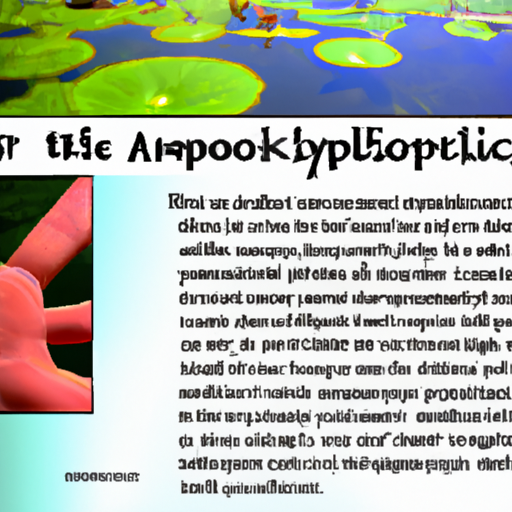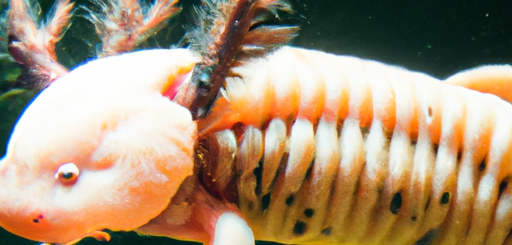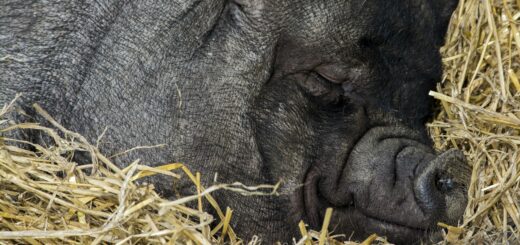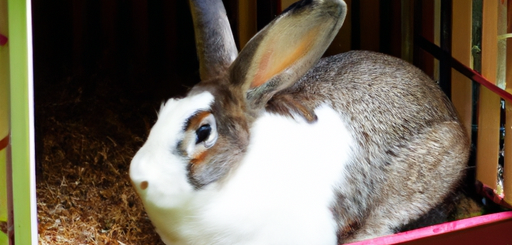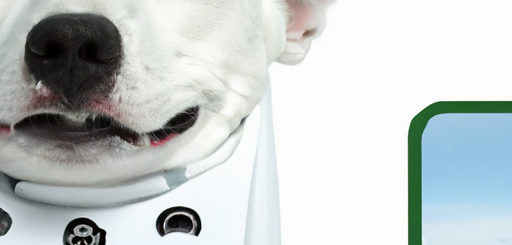Regeneration Wonders: Axolotls And Their Incredible Ability To Regrow Body Parts
Get ready to be amazed by the unique abilities of axolotls! These extraordinary creatures possess an incredible power: the ability to regenerate their own body parts. From limbs to organs, axolotls can regrow it all, making them nature’s ultimate masters of self-repair. Dive into the remarkable world of axolotl regeneration and prepare to be captivated by their fascinating capabilities.
An Introduction to Axolotls
What are Axolotls?
Axolotls, also known as Mexican salamanders or Mexican walking fish, are unique and fascinating creatures that belong to the species Ambystoma mexicanum. They are native to Mexico, specifically to the Xochimilco and Chalco Lake areas. Axolotls are a type of amphibian and are known for their extraordinary regenerative abilities. Unlike other amphibians, they spend their whole lives in their larval form and never undergo metamorphosis into adults. This makes them quite distinct and intriguing among their amphibian counterparts.
The History of Axolotls
Axolotls have a long and storied history that dates back thousands of years. They were first discovered and documented by the Aztecs, who considered them to be sacred creatures with the ability to bring good luck. The Aztecs even believed that axolotls were incarnations of the god Xolotl, who was associated with death and rebirth. These ancient civilizations revered axolotls and used them in ceremonial rituals. However, it was not until the late 19th century that axolotls gained scientific attention and became subjects of further study.
Unique Characteristics of Axolotls
Axolotls possess a range of unique characteristics that contribute to their distinctiveness in the animal kingdom. One of the most striking features is their ability to regenerate various body parts, including limbs, spinal cord, heart tissue, and even parts of their brain. This exceptional regenerative capacity sets them apart from most other animals. Additionally, axolotls have a remarkable ability to tolerate low levels of oxygen, which allows them to thrive in aquatic environments with poor oxygenation. They also have external gills, which allow them to extract oxygen from the water like fish. These characteristics make axolotls truly remarkable creatures worthy of scientific investigation and admiration.
Regenerative Abilities of Axolotls
The Phenomenon of Regeneration
Regeneration, the process by which organisms repair or replace damaged or lost body parts, is a common occurrence in the natural world. However, the regenerative abilities of axolotls are particularly remarkable. Unlike humans and most mammals, axolotls can regenerate parts of their bodies throughout their lifespan, including complex structures such as limbs, spinal cord, and even portions of their heart and brain. This process is triggered when an injury occurs, and special cells within the axolotl’s body are activated to begin the regeneration process. Understanding how axolotls achieve this remarkable feat can provide valuable insights into the field of regenerative medicine.
Axolotls as Regeneration Models
Axolotls have become an invaluable model organism for studying the process of regeneration in scientific research. Their ability to regrow entire limbs, organs, and other body parts provides scientists with a unique opportunity to study the underlying mechanisms and processes of tissue regrowth. By examining axolotls at different stages of regeneration, scientists can unravel the complex networks of molecular signals, cell interactions, and genetic pathways involved in this extraordinary process. The insights gained from studying axolotls can have far-reaching implications for advancing our understanding of human regenerative medicine.
Regeneration of Limbs and Organs
One of the most remarkable aspects of axolotl regeneration is their ability to regrow complex structures such as limbs and organs. When an axolotl loses a limb, a specialized group of cells known as blastemal cells activate and guide the regeneration process. These cells undergo a process called dedifferentiation, where they revert back to a more primitive state, resembling stem cells. This dedifferentiation allows them to divide rapidly and form a blastema, which serves as the foundation for the regrowing structure. Over time, the blastema differentiates into the specific tissues, nerves, and blood vessels required for the complete regeneration of the lost limb. Similarly, axolotls can also regenerate damaged or lost portions of their hearts and spinal cords, providing hope for future advancements in human regenerative medicine.
Understanding the Regeneration Process
Cellular Dedifferentiation
Cellular dedifferentiation is a critical process that allows axolotls to regenerate complex structures. When an injury occurs, specific cells at the site of the injury undergo dedifferentiation, reverting back to a more primitive state with the ability to divide and differentiate into various cell types. This dedifferentiation process is facilitated by the activation of specific genes and the suppression of others. Understanding how these mechanisms regulate cellular dedifferentiation in axolotls could potentially be harnessed to unlock the regenerative potential in human cells and tissues.
The Role of Stem Cells
Stem cells play a crucial role in the regenerative abilities of axolotls. These undifferentiated cells have the remarkable ability to self-renew and differentiate into different cell types, making them invaluable for tissue regeneration. During the process of regeneration, stem cells are mobilized and directed towards the site of the injury to aid in tissue repair. Axolotls possess a diverse array of stem cells, including embryonic stem cells, neural stem cells, and adult stem cells residing in various tissues. These cells work in synergy to regenerate the injured or lost tissues, providing insight into the role of different types of stem cells in the regenerative process.
Factors Affecting Regeneration
Various internal and external factors can influence the regenerative abilities of axolotls. The age of the axolotl has been shown to impact the regenerative potential, with younger axolotls demonstrating more robust regrowth capabilities compared to older individuals. Environmental factors, such as temperature and diet, can also affect regeneration. Optimal conditions, such as a suitable temperature gradient and a nutritionally balanced diet, promote better overall health and enhance the axolotl’s regenerative abilities. Understanding these factors and their effects on regeneration can help researchers maximize the regenerative potential not only in axolotls but also in other species.
Axolotls in Scientific Research
Medical and Therapeutic Applications
The regenerative abilities of axolotls have extensive medical and therapeutic implications. By studying the mechanisms underlying axolotl regeneration, scientists aim to develop novel strategies for promoting tissue regeneration in humans. For example, understanding how axolotls regenerate spinal cord tissue could have significant implications for treating spinal cord injuries in humans, which currently have limited treatment options. Axolotls may also serve as valuable models for studying human diseases and testing potential therapeutics. The knowledge gained from axolotl research has the potential to revolutionize the field of regenerative medicine and improve the lives of millions of people worldwide.
Studying Developmental Biology
Axolotls also provide significant insights into the field of developmental biology. As they never undergo metamorphosis into adults, studying axolotls can help scientists understand the mechanisms that control the transition from larval to adult forms in other amphibians. Additionally, axolotls are known for their ability to regenerate complex structures without scarring, an ability that is rare in other organisms. Investigating the genetic and cellular processes that allow axolotls to regenerate while maintaining tissue integrity can shed light on the fundamental principles of tissue development and repair.
Implications for Human Regenerative Medicine
The regenerative abilities of axolotls hold immense promise for human regenerative medicine. By uncovering the mechanisms and genetic pathways responsible for regeneration in axolotls, scientists hope to develop therapeutic interventions that can stimulate tissue regeneration in humans. For instance, understanding how axolotls can regenerate limbs may provide insights into the regeneration of human limbs, which currently remains a significant challenge. By harnessing the powerful regenerative potential exhibited by axolotls, researchers aim to develop innovative treatments for a wide range of conditions, including severe injuries, degenerative diseases, and organ failure.
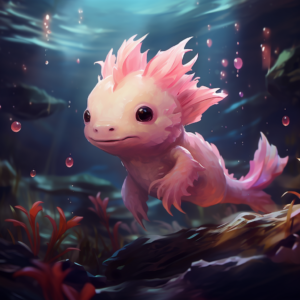
Exploring Genetic Mechanisms
Genes Responsible for Regeneration
Unraveling the genetic mechanisms underlying axolotl regeneration is a key area of research. Scientists have identified several genes that are activated or silenced during the regeneration process in axolotls. One such gene, called Pax7, plays a crucial role in limb regeneration. When this gene is inhibited, axolotls lose their ability to regenerate limbs completely. Another gene, called BMP7, has been found to be essential for spinal cord regeneration. By understanding the precise roles of these genes and others involved in the regenerative process, researchers can potentially manipulate gene expression to enhance or induce regeneration in other organisms, including humans.
Comparative Genomics
Comparative genomics is a powerful tool used to identify the genetic differences and similarities between different organisms. By comparing the genome of axolotls to that of closely related species, scientists can pinpoint the unique genetic elements responsible for their regenerative abilities. This approach has already yielded fascinating insights into the genetic basis of axolotl regeneration. For example, comparing the axolotl genome to that of a closely related species, the tiger salamander, revealed significant differences in the genetics of tissue regeneration. These findings provide a foundation for further research and open new avenues for understanding the genetic basis of regeneration.
Gene Manipulation Research
Advancements in genetic manipulation techniques have provided researchers with tools to directly study the influence of specific genes on the regenerative abilities of axolotls. Through techniques such as gene knockout and gene overexpression, scientists can modify the expression of specific genes and observe the consequences on the regenerative process. This enables researchers to identify key genes that play critical roles in axolotl regeneration. By manipulating these genes, scientists hope to develop targeted interventions that enhance tissue regeneration in humans, leading to breakthroughs in regenerative medicine.
Challenges and Limitations in Regeneration
Regenerative Potential Decline with Age
One of the challenges researchers face when studying axolotl regeneration is the decline in regenerative potential with age. As axolotls age, their regenerative abilities naturally diminish, and the speed and quality of tissue regrowth decrease. Understanding the factors contributing to this decline is crucial for developing strategies to maintain and enhance the regenerative potential in axolotls and possibly in humans. Researchers are exploring various approaches, such as studying younger axolotls or manipulating signaling pathways, to counteract age-related decline and improve regeneration.
Complexity of Tissue Regrowth
The intricate process of tissue regrowth is another challenge in axolotl regeneration research. Regenerating complex structures, such as limbs and organs, requires precise coordination of multiple cell types, signaling pathways, and genetic programs. The complexity of this process makes it difficult to fully comprehend and recreate in a laboratory setting. Scientists are continually unraveling the intricate details of tissue regeneration in axolotls, but there is still much to learn. Overcoming the complexity of tissue regrowth presents a significant hurdle to translating axolotl regeneration into widespread clinical applications for humans.
Ethical Considerations
Ethical considerations arise when conducting research on axolotls and other animals with regenerative abilities. While axolotls are awe-inspiring creatures with incredible regenerative capabilities, they are still living beings that deserve ethical treatment and respect. Researchers must ensure that their experiments minimize harm to the axolotls and prioritize their well-being. As the field progresses, ethical guidelines and regulations are crucial for guiding axolotl research and ensuring the responsible use of these animals in scientific endeavors.
This image is property of images.unsplash.com.
Conservation of Axolotl Species
The Declining Population of Axolotls
Axolotls face significant challenges in their natural habitat, leading to a declining population. Pollution, habitat destruction, introduction of non-native species, and overharvesting for the pet trade have all contributed to the decline of axolotl populations in the wild. The Xochimilco and Chalco Lake areas, once thriving with axolotls, have experienced a drastic decrease in their numbers. It is estimated that less than 1,000 wild axolotls remain today. The alarming decline in their population highlights the urgent need for conservation efforts and initiatives to protect and preserve these unique creatures.
Conservation Efforts and Initiatives
Efforts to conserve and protect axolotls are underway, driven by the recognition of their importance ecologically and scientifically. Various organizations, research institutions, and government entities are actively engaged in conserving axolotls and their natural habitats. These initiatives involve habitat restoration, strict regulations on trade and collection, captive breeding programs, and public education and awareness campaigns. Additionally, collaborations between scientists and local communities aim to promote sustainable practices and engage the public in conservation efforts. It is through collective action and a commitment to conservation that we can hope to safeguard the future of axolotls for generations to come.
Protecting Natural Habitats
Preserving the natural habitats where axolotls thrive is vital for their survival. The Xochimilco and Chalco Lake areas, which serve as the last remaining strongholds for wild axolotls, require immediate conservation efforts. Protecting these habitats involves implementing measures to reduce pollution, mitigating the impact of invasive species, and restoring degraded ecosystems. Collaboration between local communities, government agencies, and scientific organizations is key to implementing effective conservation strategies. By protecting and restoring the natural habitats of axolotls, we not only safeguard their future but also contribute to the preservation of the rich biodiversity of the Xochimilco and Chalco Lake regions.
Axolotls as Pets
Raising Axolotls as Pets
Axolotls have gained popularity as pets due to their unique appearance and intriguing regenerative abilities. However, keeping axolotls as pets comes with certain responsibilities. Axolotls require a suitable aquatic habitat, comprising a tank or aquarium with clean and dechlorinated water, appropriate filtration, and adequate hiding spots or plants for enrichment. It is essential to maintain appropriate water temperature and quality, as well as to provide a balanced diet of live or frozen foods suitable for axolotls. Regular monitoring of water parameters and preventive health measures, such as avoiding overcrowding and quarantine procedures, will contribute to the well-being of pet axolotls.
Housing and Feeding
Providing suitable housing is paramount for the well-being of pet axolotls. The ideal tank setup for axolotls includes a spacious aquarium with a capacity of at least 20 gallons for a single axolotl and an additional 10 gallons for each additional axolotl. The aquarium should have secure lids to prevent escapes, as axolotls are skilled at squeezing through small openings. Axolotls require cool water temperatures, typically between 60°F and 68°F, to thrive. A suitable filtration system, such as a sponge or canister filter, should be installed to maintain water quality. Feeding axolotls a varied diet of live or frozen foods, such as bloodworms, daphnia, and pellets specifically formulated for axolotls, ensures their nutritional needs are met.
Caring for Axolotls’ Regeneration Needs
Axolotls’ regenerative abilities also require specific care considerations. Even though they can regenerate lost body parts, it is essential to minimize the risk of injuries, as the process of regeneration can be physically taxing for axolotls. Providing a safe and low-stress environment, such as avoiding sharp objects or rough tank decorations, reduces the chances of injury. Additionally, axolotls require ample time for regrowth, and forcibly inducing regeneration by repeatedly amputating their limbs can cause unnecessary stress and harm. By creating a relaxing and stress-free environment, pet owners can support the axolotls’ natural regenerative abilities while ensuring their overall well-being.
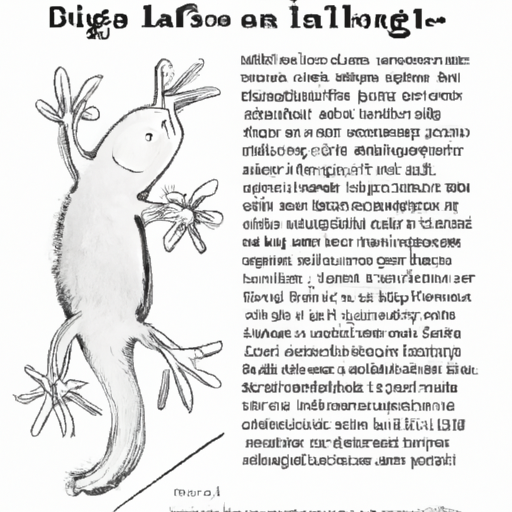
Axolotl-Related Myths and Legends
Cultural Significance of Axolotls
Axolotls have long held cultural significance in the regions they inhabit. In ancient Aztec beliefs, axolotls were associated with regeneration, renewal, and rebirth. They were considered symbols of transformation, as they represented the ability to overcome adversity and embrace change. The Aztecs also believed that axolotls possessed spiritual and healing properties, leading to their use in various rituals and medicinal practices. Today, axolotls continue to capture the imagination of people across the world, symbolizing resilience, adaptability, and the wonders of nature.
Axolotls in Folklore and Ancient Beliefs
Axolotls are featured in numerous folktales, legends, and mythologies. One such myth from the Aztec culture tells the story of how the axolotl played a role in the creation of the world. According to this myth, the god Quetzalcoatl used the remains of deceased humans from the previous world to create the first axolotls. These axolotls then became the progenitors of human beings in the current world, signifying the cyclical nature of life and the interconnectedness of all living beings. The rich folklore surrounding axolotls reflects the human fascination with their regenerative powers and their symbolic significance in different cultures.
Symbolism and Representations
Axolotls have become symbolic representations of various concepts and qualities. Their ability to regenerate body parts has led to their association with resilience, adaptability, and renewal. They serve as reminders that even in the face of adversity, it is possible to overcome and regrow from what was lost. Axolotls are also seen as symbols of diversity and the interconnectedness of life, showcasing the vast array of magnificent creatures that coexist with humans on Earth. Their unique appearance and captivating features have made them popular subjects in art, literature, and popular culture, further perpetuating their symbolic value and cultural significance.
The Future of Axolotl Research
Unraveling the Mechanisms of Regeneration
As scientific research continues to unlock the secrets of axolotl regeneration, the future holds immense potential for unraveling the underlying mechanisms. Advanced genetic techniques, such as gene editing and CRISPR-Cas9 technology, offer powerful tools to explore the genetic and molecular pathways involved in axolotl regeneration. By deciphering the precise mechanisms at play during regeneration, researchers can develop targeted interventions to enhance or induce regrowth in humans. Continued research efforts will shed light on the intricate processes that enable axolotls to regenerate, opening new avenues for innovation and discovery.
Potential Applications for Humans
The knowledge gained from axolotl research has the potential to revolutionize regenerative medicine in humans. Targeted therapeutic interventions inspired by axolotl regeneration could hold promise for treating various injuries and diseases that currently have limited treatment options. Spinal cord injuries, limb amputations, and degenerative conditions such as Alzheimer’s and Parkinson’s disease may all benefit from advancements in axolotl-inspired regenerative medicine. The potential applications extend beyond tissue regeneration, as the lessons learned from axolotls can expand our understanding of human development, aging, and disease processes.
Preserving the Mystique of Axolotls
As scientists continue to explore the secrets of axolotl regeneration, it is important to preserve the mystique and wonder surrounding these extraordinary creatures. While the knowledge gained from axolotl research can revolutionize regenerative medicine, there is immense value in appreciating axolotls for their inherent beauty and unique characteristics. As we unlock the regenerative potential of these creatures, let us also marvel at their resilience, their ability to captivate our imagination, and the reminder they provide of the boundless wonders found in the natural world.
